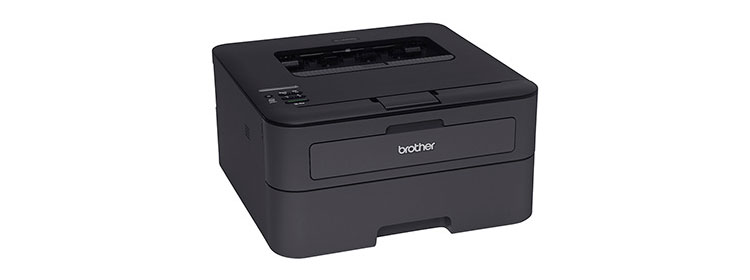Despite being small enough to fit comfortably on your desk, the Brother HL-L2360DW monochrome laser printer ($149.99) offers speed and paper handling suitable for most micro offices. Its output quality was somewhat below par in our tests, but it’s still good enough for most business use. The combination makes it a reasonable choice as either a heavy-duty personal printer or as a light- to moderate-duty shared printer in a micro or small office.
Paper handling is one of the HL-L2360DW’s$99.99 at Best Buy strengths, and a key area where the printer offers a point-for-point match with the Samsung Xpress M2825DW $140.45 at Amazon, our Editors’ Choice for low-cost personal or micro-office mono lasers. Both printers offer a 250-sheet input tray, a one-sheet manual feed, a duplexer (for two-sided printing). If you need a higher paper capacity, you’ll have to look elsewhere, but, with either printer, this should be enough for most micro offices.
Connection options for the HL-L2360DW include Ethernet and Wi-Fi, which makes it easy to share the printer in a micro office, plus Wi-Fi Direct, which lets you connect directly to the printer from a mobile device, even if you connect the printer to a single PC by USB cable. Brother’s free mobile print app lets you print from iOS, Android, Kindle Fire, and Windows mobile devices either directly, using Wi-Fi Direct, or through your Wi-Fi access point. If the network is connected to the Internet, you can print through the cloud.
Setup, Speed, and Output Quality
At 7.2 by 14.0 by 14.2 inches (HWD), the HL-L2360DW takes up less desktop space than most inkjets, and at only 15 pounds, it’s light enough for one person to move into place easily. Setting it up on a network is standard fare. For my tests I connected it by Ethernet and installed the drivers on a Windows Vista system.
On our business applications suite (using QualityLogic’s hardware and software for timing) I clocked the printer at 9.6 pages per minute (ppm). That qualifies as a reasonable speed for both the price and the 32-ppm rating. It’s also essentially tied with the Samsung M2825DW. However, it’s well short of impressive. By comparison, the Brother HL-2270DW$139.99 at Amazon, which the Samsung printer replaced as our Editors’ Choice, came in at 11.7ppm. The Canon imageClass LBP6200d$169.00 at PCNation.com clocked in at 11.1ppm in its default duplex mode and at 14.5ppm in simplex (one-sided) mode.
Unfortunately, the HL-L2360DW’s output quality doesn’t hold up against the competition. Text quality is good enough for most business use, but it’s below par for a monochrome laser. The saving grace is that even subpar text for a laser is better than you’ll get from most inkjets. I wouldn’t consider this printer for high-quality desktop publishing, but for typical business use, unless you have an unusual need for small fonts, it should work for you.
Graphics output is at the low end of a fairly tight range that includes virtually all monochrome lasers. It’s good enough for any internal business need, but not for something you’ll want to hand out to a client or customer when you’re trying to make a good impression. Photo quality is typical for its ilk. That translates to being good enough to print recognizable images from photos in Web pages, or roughly equivalent to newspaper quality.
If you want speed, the Canon LBP6200d can be an attractive choice, but its only connection option is USB, which limits it to personal, rather than shared, use. If you need better output quality than the Brother HL-L2360DW offers, take a close look at the Samsung M2825DW, which delivers higher-quality text and graphics as part of a balance of features that makes it our preferred pick. If you don’t need particularly high-quality output, however, the HL-L2360DW matches the Samsung printer for speed, paper handling, connection options, and mobile printing support, making it a reasonable, though not particularly compelling, choice.







